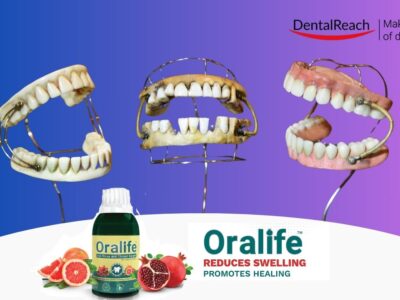Author Dr Supriya Joshi (BPTh, Masters, Sports Science) is a Sports Physiotherapist & Ergonomist from Pune, India. Dr Supriya is a Symposium Panelist at the DentalReach Conference & Awards (DRDCA) 22: Sports Dentistry Edition. Brochure & Registration Link: Click here

Overview
Sports physiotherapy is a branch of physical therapy that is geared towards both athletes and casual players who have suffered an injury or want to prevent one. Sports physiotherapy is a specialized form of physiotherapy which is designed to help with injuries or conditions occurred during sports activities. The modalities include hands-on treatment and rehabilitation. It is a safe, secure, and effective way to help get the athlete back on track as soon as possible.
Sports activities, whether professional or otherwise, can cause muscle strain or even serious injuries. If these problems are not given proper medical attention and treatment, they can worsen. However, these unwanted injuries can now be alleviated and prevented from happening again through the application of sports physiotherapy. It can also help the athlete maximize their performance.
The key areas of sports physiotherapy include:
- Prehabilitation
- Examining and diagnosing injuries
- Identifying the cause of an injury
- Designing an individual treatment plan
- Rehabilitation
- Performance enhancement
Types of sports injuries requiring physiotherapy
Sports injuries are commonly caused by
- over-use
- direct impact
- application of forces which are greater than which the body part can structurally withstand
- improper training practices
- incorrect warm-up or stretching before the event.
The sports injuries are generally classified as acute, sub-acute or chronic depending on the duration of the injury. Common injuries include bruises, sprains, strains, contusions or joint injuries.
Different sports injuries produce different symptoms and complications. The most common types of sports injuries requiring physiotherapy include:
- Sprains. Overstretching or tearing the ligaments results in a sprain. Ligaments are joint stabilizers that connect two bones to one another in a joint.
- Strains. Overstretching or tearing muscles or tendons results in a sprain. Tendons are thick, fibrous cords of tissue that connect bone to muscle.
- Fractures. broken bones.
- Dislocations. Sports injuries may dislocate a bone in the body. When that happens, a bone is forced out of its socket. This can be painful and lead to swelling and weakness.
Sports Pre-habilitation
Studies show that ,more than 40% sports injuries occur due to incorrect postures during the practice or game. Good news is, they are avoidable!
Clinical evaluation tools are used by physiotherapists to forecast joint problems. This helps in planning a Pre-habilitation.
The goal of prehabilitation program is to maximize the output and minimize the energy expenditure.
It is targeted on development of muscle fitness, strength training, flexibility and balance along with cardio vascular fitness.
Prehab helps athletes to achieve targeted results for muscle specific activation and training. Following a systematic and planned prevention program is highly beneficial for players in all the phases of their game.
Experts have advocated three “E’s” of injury prevention which include Education, Engineering and Enforcement.
The most important aspect of prevention is providing accurate and sports specific ergonomic education to reduce the risk of injuries.
Sports Re-habilitation
Losing freedom of movement due to an orthopedic injury or surgery can be challenging. It is very important for a professional and recreational athlete to get back on field with confidence after sports injury. The physiotherapist’s approach goes beyond addressing pain. Effective therapies are provided to facilitate early return to an active lifestyle.
Sports injuries are high-performance injuries that require utmost care. A Sports physiotherapist works closely with the athlete/ team to identify the requirements of a particular sport and bring out the best result post-injury in performance.
For instance, a midfield footballer injures his ankle while playing football and goes through rehab. He is given specialized rehab exercises to be able to run, cut directions and manipulate the ball like pre-injury as per his sport. Depending on the sport a customized rehab program is designed to assist the athlete back to the sport. If it’s a cricket injury like hyperextension in a fast bowler, then the bowler is guided to exercises that prevent hyperextension or stabilize the spine and assist in his return to cricket.
Sports physiotherapy can provide various treatment modalities. The treatment approaches towards back pain and neck pain in regular patients are dealt with various treatment techniques used in sports therapy and mainly on movement rehabilitation. For instance, running has been taken up by many regular individuals for fitness, but they struggle with injuries due to a lack of guidance.
In an acute injury, The RICE method is a common treatment regimen for sports injuries. It stands for:
- Rest
- Ice
- Compression
- Elevation
This treatment method is helpful for mild sports injuries. For best results, the RICE method is followed within the first 24 to 36 hours after the injury. It can help reduce swelling and prevent additional pain and bruising in the early days after a sports injury.
Once the acute inflammation reduces, depending on the extent of injury physiotherapy is planned for sports rehabilitation.
Sports rehabilitation plays a very important part of an athlete’s sport life. Sports Therapy can be broadly divided into 5 phases which are as follows
- Reduction of Pain and Swelling
- Restoration of Joint Mobility and Range of Motion
- Recovery of Muscle Strength and Endurance
- Recovery of Co-ordination
- Recovery of sports- specific technical movements
Sports Physiotherapy and Dentistry
TMJ dysfunction is one of the chronic orofacial pain conditions and is associated with symptoms related to head and neck including headache, otitis, neck pain, and it may affect patient’s health related quality of life.
Physiotherapy has a crucial role in treating temporomandibular disorders (TMD) as an effective intervention to reduce pain and improve TMD symptoms.
Physiotherapists deal with TMJ as they treat other joints in the body, and use different electrotherapy modalities to reduce pain and inflammation which promotes healing of tissues. Electrotherapy modalities include:
- matrix rhythm therapy
- electrical stimulation
- ultrasound
- needling
Conservative approaches can also be used to re-establish the proper flexibility and muscular length/strength, which in turn improves mobility/function. Conservative techniques include:
- splint therapy
- massage
- manual therapy
- therapeutic exercises
- home exercises program
The awareness about this approach may help dentists to refer TMD patients to physiotherapists for better management of the condition and much better prognosis can be achieved by dentist and PTs collaboration.
Bonus – Tips on sports injury prevention you may share with your patients
Warm up & stretching
The best way to prevent a sports injury is to warm up properly and stretch. Cold muscles are prone to overstretching and tears. Warm muscles are more flexible. They can absorb quick movements, bends, and jerks, making injury less likely.
Use the proper technique
Learn the proper way to move during your sport or activity. Different types of exercise require different stances and postures. For example, in some sports, bending your knees at the right time can help avoid an injury to your spine or hips.
Have the proper equipment
Wear the right shoes. Make sure you have the proper athletic protection. Ill-fitting shoes or gear can increase your risk for injury.
Don’t overdo it
If you do get hurt, make sure you’re healed before you start the activity again. Don’t try to “stretch through” the pain.
Cool down
Remember to cool down after your activity. Usually, this involves doing the same stretching and exercises involved in a warmup.
Let us discuss, in details about this and the inter-relationship between sports physiotherapy and dentistry at the session and panel discussion at the DRDCA 22 Conference!




















Comments